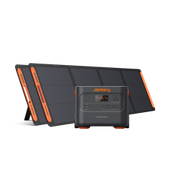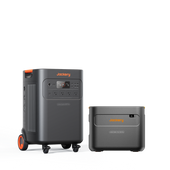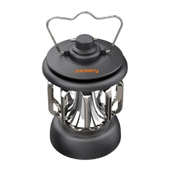There is nothing quite like escaping the hustle and bustle of city life and going on an RV trip. However, many people imagine a noisy gas generator in the background when they think of RV living. But it doesn't have to be this way. Solar battery chargers for RVs sound like the perfect alternative to gas-guzzling RV generators. They are compact enough to fit in the RV and quiet enough for comfortable sleep at night.
If you want to make the RV experience a quiet getaway, you can consider going ahead with the Jackery Solar Generators. They are compact and robust solar-powered generators that can charge most RV appliances for long hours. However, finding the right size of solar generator for an RV can be quite tricky. This guide will reveal the top four picks for the best RV solar generators, along with how to choose the right generator size for RVs.
How Solar Battery Charger Work for RV
Jackery Solar Generators combine Jackery Portable Power Stations and Jackery SolarSaga Solar Panels, which work in tandem to collect, convert, and generate electricity from sunlight. The solar panels can be unfolded and placed under direct sunlight to absorb sunlight and produce DC electricity.
The portable power station has a pure sine wave inverter that converts DC to AC electricity to charge RV appliances like mini freezers, coffee makers, TVs, and more. Since the power stations and solar panels are portable by nature, you can carry them outside the RV to power outdoor appliances during camping, fishing, hiking, and even cooking.
If you want to go entirely solar and charge the RV battery with the free solar energy, there are Jackery SolarSaga 100 Prime Solar Panels available. Their flexible design ensures you can install them at the top of the RV. The solar panels are then connected to the MPPT charge controller, which is further connected to the RV battery to charge it.

What Size Solar Charger for an RV?
The size of the RV battery solar charger will depend on the amount of electricity needed to charge the appliances. The simple method to choose the size of the generator needed to run an RV is to calculate the total wattage required to charge the electricity in the RV. If you want a quick estimate, here is the sizing of the solar charger needed for the RV:
300-watt generator: Suitable for powering small appliances and outdoor activities such as fishing outside the RV.
500-watt generator: Suitable for charging appliances during fishing, camping, and photography during RV living.
2000-watt generator: Suitable for small RVs such as travel trailers and pop-up campers with limited electricity needs.
4000-watt generator: Suitable for light-duty RVs and small travel trailers with essential appliances such as refrigerators.
6000-watt generator: Suitable for large RVs with heavy-duty appliances such as refrigerators, air conditioners, microwaves, and more.
Remember, the generator size will also depend on how big the RV or camper is. Here's how big of a generator you need for the camper or RV:
- Class B Van: 2000W - 3500W generator
- Class C Van:3000W - 4000W generator
- Class A (with two ACs of 15,000 BTU): 5000W - 8000W generator
- Class A (with three ACs of 15,000 BTU): 9000W - 13,000W generator
- Fifth Wheel: 5000W - 7000W generator
If you want to learn in detail, check out these articles: How big of a generator do you need for your camper, and What size generator do you need for your RV?
Best Solar Chargers for RV
If you're planning an outdoor adventure and wish to reduce the carbon footprint, you can always go ahead with the solar battery chargers for RVs. They use sunlight to generate electricity and charge appliances on the move without requiring access to power outlets.
Jackery is a well-known solar brand that manufactures high-quality solar panels, power stations, and solar generators. The Jackery Solar Generators are robust, powerful, and lightweight solar battery chargers that can charge most appliances such as lights, coolers, portable stoves, etc.
Here, we will reveal some of the best solar battery chargers for RVs:
Jackery Solar Generator 300 Plus — Best for Small Appliances
The Jackery Solar Generator 300 Plus is more than enough to charge small appliances during off-grid RV trips. The power station weighs only 8.27 lbs and has a sturdy, foldable handle for moving the solar charger in and out of the RV. It operates quietly, so you can charge the appliances at night without disturbing your sleep. If you are planning an outdoor trip in your RV and want to enjoy outdoor activities like picnicking, the Jackery Solar Generator 300 Plus would be a great pick.
Appliances Running Time
- Portable Fridge (50W) = 4.8H
- Fan (45W) = 5.4H
- Light (5W) = 48.9H
- CPAP (40W) = 6.1H
- TV (60W) = 4.0H

Jackery Solar Generator 500 — Best for Photography/Fishing around RV
If you travel in your RV but also love other outdoor activities like photography and fishing, then you would need the Jackery Solar Generator 500. With its sturdy handle, you can conveniently carry the solar battery charger to enjoy outdoor activities and charge essential appliances such as cameras, drones, lights, etc. It can also power other appliances, such as coffee makers, portable stoves, etc., to provide reliable power wherever you go.
Appliances Running Time
- Digital Camera (20W) : 22.0H
- External Flash (50W) : 8.8H
- Fishing Cooler (50W) : 8.8H
- Electric Fishing Reel (60W): 7.3H
- Fish Finder (150W): 2.9H

Jackery Solar Generator 600 Plus — Best for Camping/Fishing around RV
Are you planning to visit remote locations to enjoy camping and fishing activities with friends when living in an RV? If yes, the Jackery Solar Generator 600 Plus has enough juice to charge outdoor large appliances. It is robust and compact, making it easy to travel with and store away when not required. Its battery capacity and power output ensure that you are never without power for too long when enjoying the outdoors.
Appliances Running Time
- Cooler (90W) = 5.9H
- Coffee Maker (550W) = 58 minutes
- Fishing Cooler (50W) : 10.7H
- Electric Fishing Reel (60W): 8.9H
- Fish Finder (150W): 3.5H

Jackery Solar Generator 2000 Plus — Best for Cooking/Larger Appliances
The Jackery Solar Generator 2000 Plus is one of the most potent solar-powered generators that can charge 99% of small and large RV appliances. It works by emitting only 30dB of noise and can charge appliances at night without making a lot of noise. It has double wheels, a pull rod, and a foldable handle to move the solar battery charger in and out of the RV. It has enough battery capacity to charge outdoor cooking equipment such as electric grills and portable stoves to cook delicious meals.
Appliances Running Time
- Electric Grill (700W) = 2.4H
- Mini Fridge (150W) = 11.5H
- Ice Maker (500W) : 3.4H
- Microwave (1000W): 1.7H
- AC (1000W): 1.7H

Installation and Maintenance Tips
Solar generators are gaining immense popularity as a clean and renewable energy source. Proper installation and maintenance of the solar battery chargers will ensure optimal performance and efficiency. With proper maintenance, you can remove dust, debris, and dirt that might accumulate on the solar panels.
Here, we will reveal some of the usage, storage, and maintenance tips for Jackery Solar Generators:
- Do not use the Jackery Portable Power Stations in an extremely hot environment, such as a car, on a hot day, or in direct sunlight. This can lead to overheating and might cause a fire.
- Store the portable power station in a dry and cool place, away from fire sources, and avoid contact with corrosive substances.
- When charging the internal battery of the power station, make sure to work in a well-ventilated area.
- Use and store the solar generator in a clean and dry environment, and avoid dusty, wet environments.
- When transporting the battery pack in an RV or other motor vehicle, make sure the unit is probably secured.
- Fully charge the portable power station when using the power station for the first time.
- If the product is stored for a long period (like 3 months or 6 months), do not let the battery level drop below 20%.
- It is highly recommended that the power station should be used and recharged every three months to keep it active.
Remember, appropriate usage, maintenance, and storage of the Jackery Solar Generators will help you ensure their longevity and maintain optimal performance.
Installing the solar generator in an appropriate way is as important as maintaining it. Here is a video that will help you install the Jackery SolarSaga 100 Prime Solar Panels on the RV rooftop to build the Jackery Solar Generator 1000 Plus Roam Kit:
FAQs
Can I charge my RV battery with solar?
Yes, you can charge the RV battery with Jackery SolarSaga 100 Prime Solar Panels. You need to start by mounting these solar panels on the RV rooftop and then connecting them to the MPPT charge controller, which helps prevent overcharging the battery. Then, you can connect the MPPT charge controller to the RV battery to charge it using solar energy.
What size solar panel do I need for my RV battery?
The Jackery SolarSaga 100 Prime Solar Panels can be connected to the RV rooftop to charge the RV battery. They help you use solar energy to power off-grid adventures in remote locations.
How long will a 100-watt solar panel take to charge an RV battery?
The time taken to charge the RV battery will depend on the wattage of the battery and the capacity or power output of the panels used. Let's take an example to understand better:
Suppose you are using the Jackery SolarSaga 100 Prime Solar Panels to charge the RV battery with the capacity of 1200Wh. If the solar panels receive 5 hours of sunlight, they will produce around 500Wh of electricity daily.
Due to system inefficiencies (solar panel, charge controller, and wiring), let's assume a charging efficiency of 85% and the electricity produced is 425Wh per day.
The time it takes to charge the RV battery can be calculated using the below formula:
Time Taken = RV Battery Capacity ÷ Electricity Generated by the Solar Panels = 1200Wh ÷ 425Wh per day = 2.8 days
So, it takes 2.8 days to charge the 1200Wh battery entirely using the 100W solar panel, assuming optimal sunlight conditions for 5 hours each day, and the RV battery is completely drained.
How do I keep my RV battery charged?
There are multiple ways to charge the RV battery, and the popular options include the electricity grid and solar panels. Jackery SolarSaga 100 Prime Solar Panels are one of the best ways to power the RV battery, especially in remote locations where access to power outlets is not possible. All you need to do is connect the solar panels with an MPPT charge controller and then connect it to the RV battery for charging on the move.
Conclusion
Choosing the best solar battery chargers for RVs will depend on the power consumption of the appliances you are charging. However, the limited space on the RV rooftop and interior means you'll have to choose a powerful yet compact RV solar generator.
If you frequently boondock, you can consider one of the best solar chargers for an RV battery, like the Jackery Solar Generator 1000 Plus Roam Kit. The Jackery SolarSaga 100 Prime Solar Panels can be installed on the RV rooftop to charge the RV battery. You can connect the panels with the Jackery Explorer 1000 Plus Portable Power Station to charge the RV appliances.
Where was your last camping trip, and how did you power the RV appliances? Share your stories in the comments below! If you have questions about how to choose the right solar battery charger for your RV, write them in the comment section!








































![[Add - on] Jackery Manual Transfer Switch for Explorer 5000 Plus - Jackery](http://www.jackery.com/cdn/shop/files/add-on-jackery-manual-transfer-switch-for-explorer-5000-plus-9017324.png?v=1754016782&width=170)





















































































![Best 4 Solar Chargers for RVs & Campers [2024 Updated]](http://www.jackery.com/cdn/shop/articles/best-4-solar-chargers-for-rvs-campers-2024-updated-6978971.jpg?v=1754018764)







Leave a comment